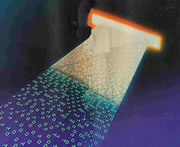| |

Banks and billers face a muddled environment of electronic and paper-based processes.
The latest technology merges mixed payments and streamlines conventional transactions.
|
|
|
|
Internet-Enabled Remittance Systems
Internet-Enabled Remittance Systems
EBPP
For the last several years analysts have trumpeted the arrival
of Internet-enabled remittance systems. Such systems go under a number
of different names: Electronic Statement Presentment (ESP), Electronic
Billing and Payment (EBP) and, most commonly, Electronic Bill Presentment and
Payment (EBPP).
One problem with EBPP is that the cost of entry is extremely
high. "The cost for implementing a low-end EBPP system ranges from
$350,000 to $750,000 - too expensive for most community banks," says Tom
Houston, whose T. Houston Technology Group has been offering community banks
consulting, marketing and training on the latest technology services since 1989.
And, then there are those complicated "strategic"
impediments.
Lack of integration holds EBPP up
Getting EBPP to work involves establishing complex relationships
between billers, consumers and financial institutions.
"The three most important things to households and
small businesses in Internet billing are convenience, convenience, and convenience.
You don't expect holiday shoppers to go out every day during the holiday season
to a different store to buy a gift. Instead, they buy gifts many-at-a-time.
Households and small businesses, like holiday shoppers, exhibit batch behavior.
Also, most households and small businesses have just one person responsible
for all bills. This person doesn't deal with bills one at a time, but
rather, tends to deal with them in batch," says Michael Weiss, director
of standards engineering at Avolent, a San Francisco-based e-billing, invoicing
and customer care vendor.
Numerous studies have shown that consumers and businesses
want their banks to be the ones to consolidate their bills on line. But
most bills don't originate at the bank. And credit card companies, utilities,
stores and on-line services like Yahoo and MSN resist releasing customer information
to financial institutions so that it can be presented together on a single Web
page.
No major stakeholder in the remittance game wishes to deed
customer information to another stakeholder. Outsourcing detailed bill
data to a third party impacts a biller's control of its customer data and control
of its customer interactions. Storing bills in-house allows the biller
to communicate with customers on a real-time basis. Just presenting a
bill and collecting payment is not enough. The user should be able to
click through the Internet bill for additional personalized services such as
customer support and product/service ordering. The biller wants the ideal
interactive experience with the customer, which is difficult to do if a detailed
bill hosted on another company's web site must be integrated with internal customer
care and order entry system hosted by the biller itself.
"Banks were smart to stay away from EBPP for a year
or two until the smoke cleared," says Errol Hau, Director of
Product Marketing at CheckFree, a leading provider of electronic billing and
payment services. "To get into EBPP you need to go out and partner with
half a dozen companies to put together an end-to-end solution. So what
the banks decided to do was to just dabble in it, and they started by giving
people on-line bank statements with some bill payment capabilities. The
assumption was that the actual bills would remain on paper. It was a nice,
easy way to increase traffic on their websites, and they have had some success
with that more limited goal."
Jupiter Communications predicts that by the end of 2001
almost 7.7 million households will have systems for paying bills online.
The number of consumers and businesses equipped to receive (present) and paying
bills online is much smaller: 2.8 million households. Jupiter estimates
that by 2005, the number of households paying bills online will surge to 25.8
million, while 40.2 million households will both present and paying bills online.
James Van Dyke, an analyst at Jupiter, predicts that EBPP "will grow more
rapidly in the next five years than either online banking or online shopping."
Lack of aggregation holds EBPP up
In addition, according to Jon Hagen, CTO at Business Logic,
an e-finance infrastructure provider based in Chicago, IL, banks are unwilling
to throw resources at EBPP until they first tackled and solved the problem of
aggregation. "From a bank's perspective, bill presentment and presentation
is not worth pursuing until you have first set up an architecture that collects
and protects all the other types of assets (401K, savings account, checking
account, brokerage, IRA) they manage."
Industry experts observe that coherent EBPP solutions will
be held hostage until these consolidation/aggregation issues work out.
|



